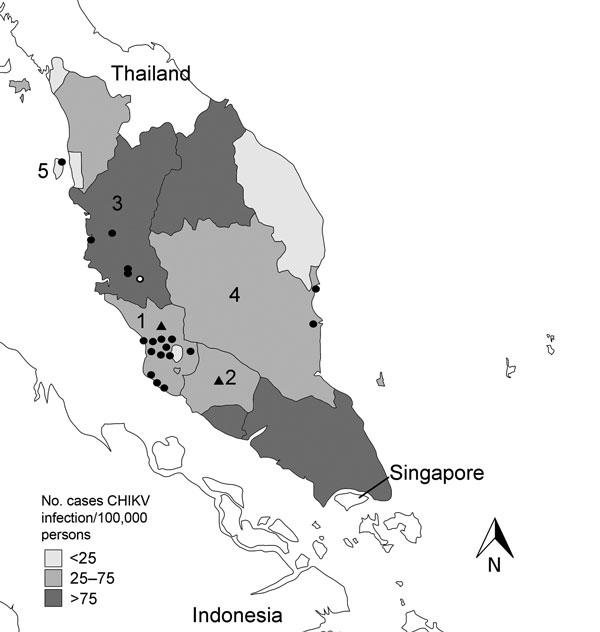Volume 21, Number 9—September 2015
Letter
Chikungunya Virus in Macaques, Malaysia
Figure

Figure. Cases of human infection with chikungunya virus (CHIKV) per 100,000 persons in 5 states in Peninsular Malaysia, 2008–2009, and sites where monkeys were sampled in 2009–2010. Published CHIKV case numbers were used (4), and published estimated populations of monkeys in 2011 were reduced by an annual growth rate of 5% to obtain population estimates for 2010 (3). Solid circles indicate monkey sampling sites, triangles indicates sites from which samples were obtained (where the specific locations was not known), and open circle indicates site from which a sample was obtained from a seropositive macaque. Numbers indicate states where monkeys were sampled. 1, Selangor, 88 monkeys (0.29%) sampled of an estimated population of 29,924; 2, Negeri Sembilan, 21/10,133 (0.21%); 3, Perak, 18/15,114 (0.12%); 4, Pahang, 17/12,590 (0.14%); 5, Penang, 3/6,019 (0.05%).
References
- Rougeron V, Sam IC, Caron M, Nkoghe D, Leroy E, Roques P. Chikungunya, a paradigm of neglected tropical disease that emerged to be a new health global risk. J Clin Virol. 2015;64:144–52 . DOIPubMedGoogle Scholar
- Diallo M, Thonnon J, Traore-Lamizana M, Fontenille D. Vectors of chikungunya virus in Senegal: current data and transmission cycles. Am J Trop Med Hyg. 1999;60:281–6 .PubMedGoogle Scholar
- Karuppannan K, Saaban S, Mustapa AR, Zainal Abidin FA, Azimat NA, Keliang CJ. Population status of long-tailed macaque (Macaca fascicularis) in Peninsular Malaysia. J Perinatol. 2014;3:2.
- Chua KB. Epidemiology of chikungunya in Malaysia: 2006–2009. Med J Malaysia. 2010;65:277–82 .PubMedGoogle Scholar
- Kam YW, Lee WW, Simarmata D, Le Grand R, Tolou H, Merits A, Unique epitopes recognized by antibodies induced in chikungunya virus–infected non-human primates: implications for the study of immunopathology and vaccine development. PLoS ONE. 2014;9:e95647. DOIPubMedGoogle Scholar
- Halstead SB, Udomsakdi S. Vertebrate hosts of chikungunya virus. Bull World Health Organ. 1966;35:89 .PubMedGoogle Scholar
- Marchette NJ, Rudnick A, Garcia R, MacVean DW. Alphaviruses in Peninsular Malaysia: I. Virus isolations and animal serology. Southeast Asian J Trop Med Public Health. 1978;9:317–29 .PubMedGoogle Scholar
- Vourc’h G, Halos L, Desvars A, Boué F, Pascal M, Lecollinet S, Chikungunya antibodies detected in non-human primates and rats in three Indian Ocean islands after the 2006 ChikV outbreak. Vet Res. 2014;45:52. DOIPubMedGoogle Scholar
- Apandi Y, Nazni WA, Noor Azleen AZ, Vythilingam I, Noorazian MY, Azahari AH, The first isolation of chikungunya virus from nonhuman primates in Malaysia. Journal of General and Molecular Virology. 2009;1:35–9.
- Labadie K, Larcher T, Joubert C, Mannioui A, Delache B, Brochard P, Chikungunya disease in nonhuman primates involves long-term viral persistence in macrophages. J Clin Invest. 2010;120:894–906. DOIPubMedGoogle Scholar